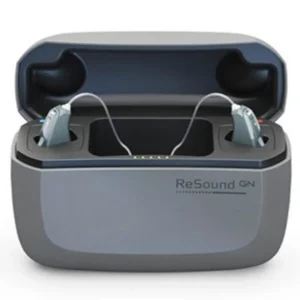Life Uninterrupted: The Convenience of Rechargeable Hearing Aids
Modern hearing aids use either disposable or rechargeable batteries. Rechargeable hearing aids have surged in popularity due to their numerous benefits. Let’s explore the advantages of hearing aids with rechargeable batteries and how they can enhance your hearing experience.
Continuous Power Supply Benefits
Rechargeable batteries provide a continuous power source, making them a preferred choice. Here are some of the pros:
- Long Shelf Life: Lithium-ion batteries hold a charge for up to 30 hours. They typically last around five years before needing replacement.
- Safety for Children: Rechargeable hearing aids eliminate the risk of children swallowing button batteries.
- Environmental Friendliness: Rechargeable batteries reduce electronic waste, making them a more sustainable option.
- Ease of Handling: Perfect for those with dexterity issues, as there’s no need to handle tiny disposable batteries.
- Economical and Green: Rechargeable hearing aids offer significant long-term savings despite a higher initial cost.
Rechargeable batteries provide a consistent power supply, ensuring optimal hearing aid performance. Depending on usage, a full charge typically lasts between 16 and 24 hours. This consistent power output is crucial for maintaining hearing aid performance throughout the day. Furthermore, rechargeable batteries can help extend the lifespan of your hearing aids, as they reduce wear and tear on the battery compartment.
Factors Influencing Battery Life
Several factors can influence the battery life of rechargeable hearing aids. Understanding these factors helps you optimize usage and extend battery life.
- Bluetooth Streaming: Bluetooth streaming significantly impacts battery life. Streaming music, phone calls, or audio directly to your hearing aids requires substantial power, draining the battery faster.
- Volume Settings: Higher volume settings demand more power, reducing battery life. Adjusting volume levels based on your environment can help conserve battery power.
- Noisy Environments: Noisy environments cause your hearing aids to work harder to amplify speech and filter out background noise, leading to faster battery drain.
- Advanced Features: Hearing aids with advanced features like directional microphones, noise cancellation, and multi-program settings might consume more power compared to basic models.
- The severity of Hearing Loss: Your hearing loss and the level of amplification needed can also affect battery consumption. Greater amplification requires more power, which can shorten battery life.
Find out more about hearing aids with Bluetooth.

Tips to Maximize Battery Life:
Optimizing your battery life is essential to get the most out of your rechargeable hearing aids. Here are some practical tips to help you maximize the performance and longevity of your rechargeable batteries:
- Charge Regularly and Fully: Fully charge your hearing aids each night. Most chargers fully charge within a few hours, so overnight charging works best.
- Keep Your Charger Accessible: Place your charger in a convenient location, such as next to your bed. This serves as a visual reminder to charge your hearing aids before going to sleep.
- Avoid Extreme Temperatures: Extreme heat or cold can affect battery performance. Store and charge your hearing aids in a room with a stable temperature, ideally between 50°F and 90°F.
- Turn Off When Not in Use: If you’re not using your hearing aids, turn them off to conserve battery power. This is particularly useful during short breaks or when you’re sleeping without the aids.
- Utilize Power-Saving Features: Many modern hearing aids come with power-saving modes or settings. These features extend battery life, especially in less demanding listening environments.
- Minimize Streaming: Bluetooth streaming is convenient but power-intensive. Limit streaming of music, phone calls, or other audio to essential times to conserve battery life.
- Regular Maintenance: Keep your hearing aids clean and free from debris. Regular maintenance ensures optimal performance and reduces the strain on the battery.
- Use Appropriate Programs: Select hearing aid programs designed for specific environments. For example, to conserve battery power, use a quieter setting when in a calm environment.
- Consult Your Hearing Professional: Regular maintenance with your hearing professional can provide valuable insights and adjustments to help you get the most out of your rechargeable hearing aids.
By incorporating these tips into your daily routine, you can maximize the battery life of your rechargeable hearing aids and enjoy uninterrupted hearing throughout the day.
Considerations and Potential Drawbacks
Despite the many benefits, rechargeable hearing aids have some potential drawbacks. They often come with a higher upfront cost compared to disposable battery models. Users depend on a charging unit, and rechargeable batteries have a limited lifespan, typically 3-5 years. Additionally, there are fewer style options available, primarily behind-the-ear models.
Discover more about hearing device types and costs.

Consider Making the Switch
Rechargeable hearing aids offer numerous benefits, from convenience to environmental friendliness. Consult with your hearing professional to find the best solution for your needs. Contact Stanford Hearing today to learn more about hearing aids with rechargeable batteries and how they can improve your quality of life.
